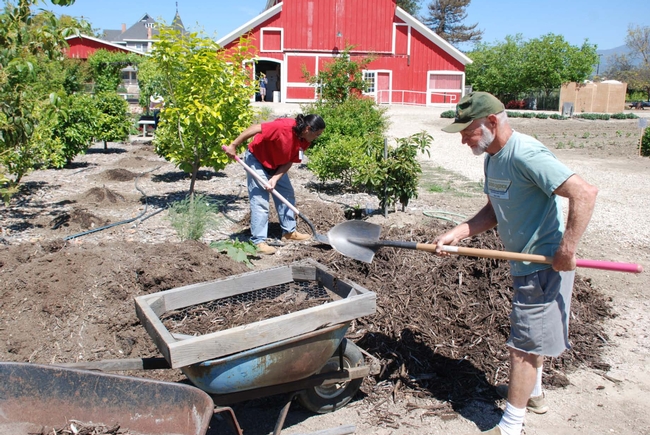
Posts Tagged: Lessons learned gardening series
Plant protection
The 2011 UC Master Gardener Vegetable Demonstration Garden Project has recently finished. A group of certified Master Gardeners and trainees spent time each week from January 27 through December 15 learning vegetable gardening techniques through hands-on experience.
They documented their project so that they could impart lessons learned throughout the2011 project. This article is the seventh in a series to share this knowledge.
Plant protection:
Necessity in protecting plants from vertebrae pests varies depending on location.
- Seedlings should be protected from animals with cages once planted in the soil.
- When constructing cages for plants, design them so they can be easily removed even if the plants become overgrown. Otherwise, the plants may be injured as the cages are removed.
- Be sure to bury the frame of the frame of the cage to prevent mice from crawling under it.
- Small grocery paper bags make nice collars for corn plants.
- Plants placed in soda bottles for protection from critters will eventually grow out of the bottle making them vulnerable to pests. Cages may provide better protection from rabbits and other grazing animals.
- Don’t leave cages on the plants too long. As the plants outgrow the cages, they will become difficult to remove. Also the stem of the plant will be weak since support provided by the cage does not allow full stem development.
Questions on gardening? Please contact our Master Gardener helpline at 645-1455 or contact them by email at mgventura@ucdavis.edu.
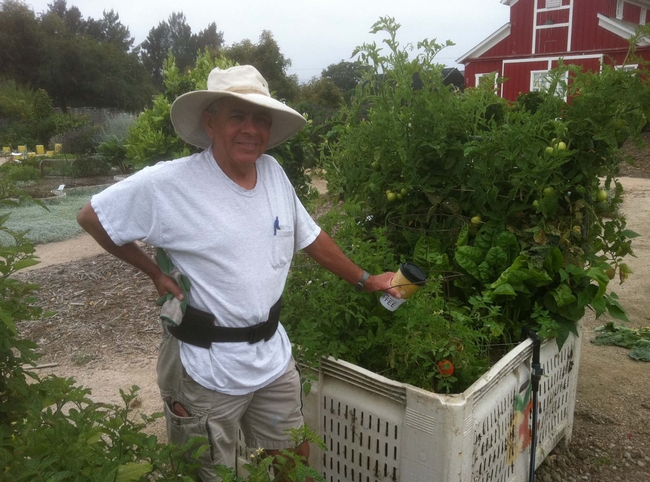
Garden Tools
The 2011 UC Master Gardener Vegetable Demonstration Garden Project has recently finished. A group of certified Master Gardeners and trainees spent time each week from January 27 through December 15 learning vegetable gardening techniques through hands-on experience.
They documented their project so that they could impart lessons learned throughout the2011 project. This article is the sixth in a series to share this knowledge.
Garden tools:
Tools in the garden can save time and effort.
- A hula hoe is a great tool to extract small weeds.
- A pocket knife is a handy tool that should be carried while gardening.
- The blades of bypass pruners and loppers should only be sharpened on one side of the blade. If they are sharpened on both sides of the blade, a small gap will be created between the blades allowing the material being cut to wedge itself between the blades and precluding a clean cut. Anvil-type pruners typically need to be sharpened on both sides of the blade. When sharpening tools, only sharpen surfaces that were originally sharpened at the factory.
Questions on gardening? Please contact our Master Gardener helpline at 645-1455 or contact them by email at mgventura@ucdavis.edu.
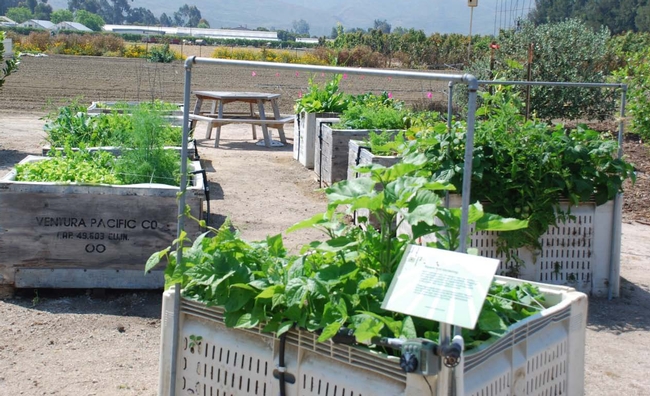
Irrigation
The 2011 UC Master Gardener Vegetable Demonstration Garden Project has recently finished. A group of certified Master Gardeners and trainees spent time each week from January 27 through December 15 learning vegetable gardening techniques through hands-on experience.
They documented their project so that they could impart lessons learned throughout the2011 project. This article is the fifth in a series to share this knowledge.
Irrigation:
Proper irrigation is vital to plant health. Drip irrigation has many benefits for plants, conserves water, and reduces weed growth. Drip irrigation systems, drip hoses or tape can be used.
- Water needs should be re-evaluated as the weather changes.
- Seedlings will die easily if they dry out.
- Install 10 psi pressure regulators on irrigation systems with flat drip tape. If a 25 psi pressure regulator is used inadvertently, it is likely that the tape will balloon up and pop during operation. 25 psi pressure regulators should be used on irrigation systems that have 3/4inch tubes and emitters.
- There are various types of pressure regulators. One type has a hole in the side and discharges a steady stream of water when the incoming pressure is high, which wastes a lot of water. Look for a pressure regulator that does not discharge water.
- When inserting .710 inch O.D. tubing (blue stripe) into a .700 inch O.D. fitting (black fitting), use soapy water to reduce the resistance. Hold the tubing with sandpaper to improve your grip.
- Avoid getting dirt in irrigation tubes and fittings, since it may clog the emitters. Flush the system to make sure that any debris is forced out the end of the tubing, before closing.
- When inserting irrigation tubing into tees and elbow fittings, be careful not to push the tubing in too far. Normally, there are no stops to prevent the tubing from going in too far. Tubing that is inserted too far can cause flow restrictions.
Questions on gardening? Please contact our Master Gardener helpline at 645-1455 or contact them by email at mgventura@ucdavis.edu.
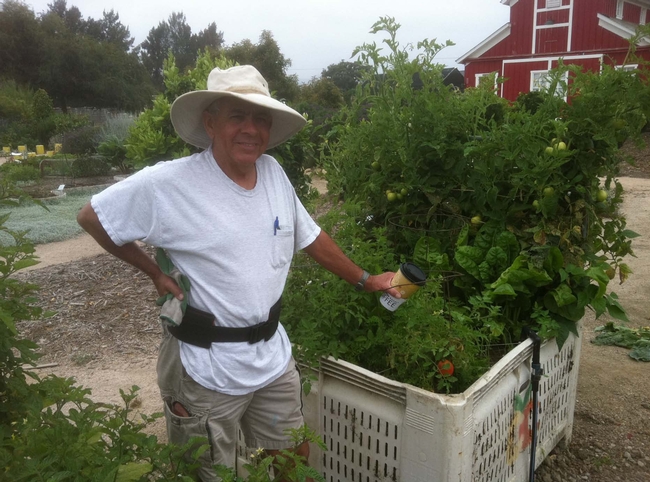
Garden Planting
The 2011 UC Master Gardener Vegetable Demonstration Garden Project has recently finished. A group of certified Master Gardeners and trainees spent time each week from January 27 through December 15 learning vegetable gardening techniques through hands-on experience.
They documented their project so that they could impart lessons learned throughout the2011 project. This article is the fourth in a series to share this knowledge.
Garden planting:
Gardens can be planted directly with seeds or seedling transplants.
- In general, you should transplant all vegetable seedings at the same depth at which they originally grew in their planting mix. However, tomatoes and peppers can be planted up to their first true leaves. Adventitious roots (link to definition) growing along the stems on these vegetables will create stronger plants.
- Seedlings need to be hardened before transplanting them to the garden.
- Corn has a better chance of survival if seeded directly into the ground.
- Grow lettuce during cool seasons to avoid bolting (link to definition).
- If you transplant seedlings that have been exposed to low levels of light to full sun without a transition period, the plants may drop all their leaves. This stress could kill the seedlings. Gradually expose the seedlings to full sunlight. This may take a week or two.
- Cucumbers, melons, and squash are especially difficult to transplant. The root system is very fragile and can be damaged if the surrounding soil falls away during transplanting. These seeds may be better handled by planting them directly into the soil where the plants will reside.
- When rooting tomato cuttings, perform the rooting procedure quickly so that the cutting does not wilt. Wilting stresses the plant, making it more difficult to survive.
- Avoid seeding an area too heavily, otherwise plants will be stunted and provide a poor yield. Thin seedlings if necessary.
- Avoid keeping plants in six-packs too long. They will become stressed and may not do well after transplanting (e.g., stunted, poorly-developed plants).
- Watermelon and cantaloupe plants should be planted early in the season to increase probability of fruit.
Questions on gardening? Please contact our Master Gardener helpline at 645-1455 or contact them by email at mgventura@ucdavis.edu.
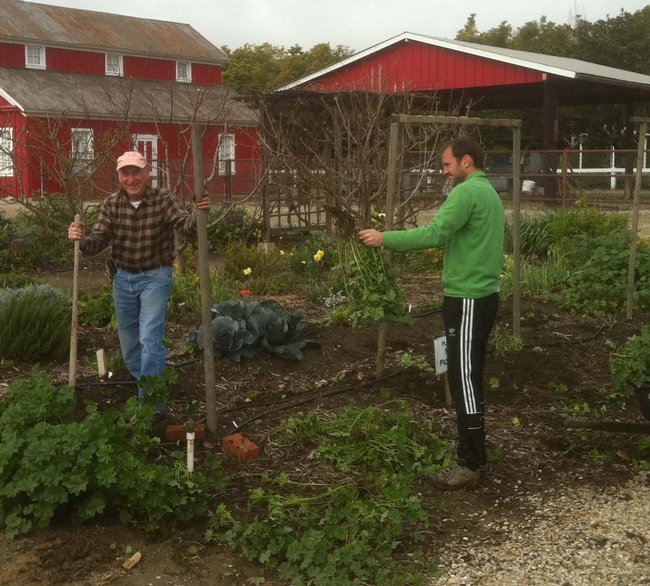
Soil Preparation
The 2011 UC Master Gardener Vegetable Demonstration Garden Project has recently finished. A group of certified Master Gardeners and trainees spent time each week from January 27 through December 15 learning vegetable gardening techniques through hands-on experience.
They documented their project so that they could impart lessons learned throughout the2011 project. This article is the third in a series to share this knowledge.
Soil preparation:
Healthy soil is key for healthy plants. Preparing soil before planting can improve nutrients available for uptake and water holding capacity.
- The moisture content of the soil is critical when tilling. The soil should not be too wet or too dry. Irrigation lines should be removed several days before tilling.
- When transporting compost in a pickup truck, make sure you have a tarp and the necessary tie down lines to adequately cover the pile. Otherwise, compost will be lost during transit.
- Make sure you have and use protective equipment when using tilling machinery (e.g., ear plugs, solid shoes and safety glasses)
- Tilling can create an interface between the soft tilled soil and the hard soil below. This interface can be a barrier to roots and water flow. To minimize this, double dig or loosen the soil below the tilling depth.
- It is easy for a tiller to lunge forward. Remove any items from the area that could get caught in the tines during tilling (e.g., irrigation lines)
- Extensive vegetative growth was observed on many of our plants. This could be because the soil was amended with copious amounts of compost. A soil test can be used to determine what level of nutrients are in the soil (make link to soil test kit blog post). If needed, phosphorous can be added to encourage more flower and fruit formation. Mulching with compost might be a better option than rototilling the compost into the soil because the nutrients will be released in a more controlled fashion.
- If peat moss and vermiculite are added to the soil and then tilled in, the tiller will go much deeper than it would otherwise. Care is needed to avoid overloading and stalling out the tiller.
Questions on gardening? Please contact our Master Gardener helpline at 645-1455 or contact them by email at mgventura@ucdavis.edu.
